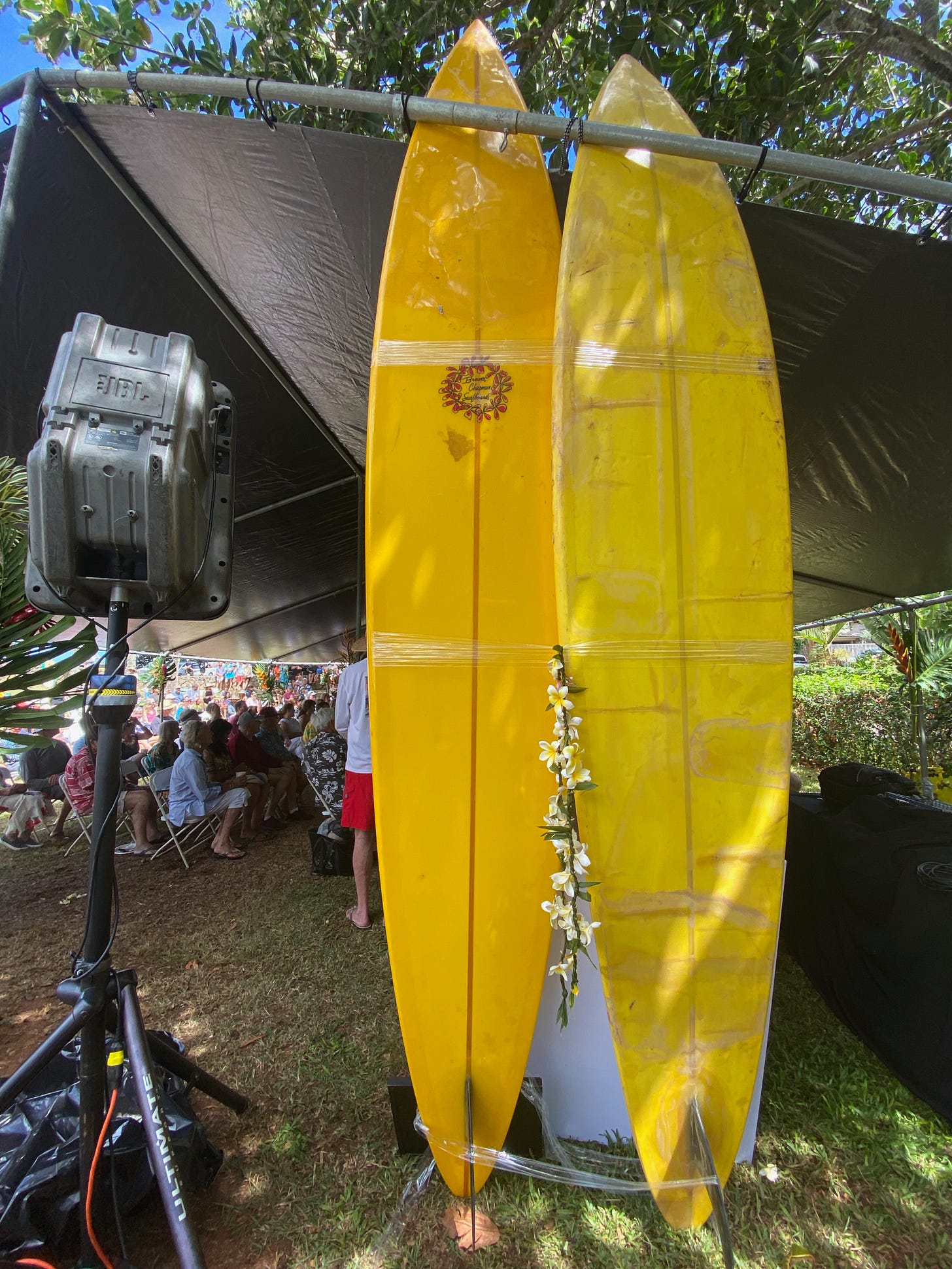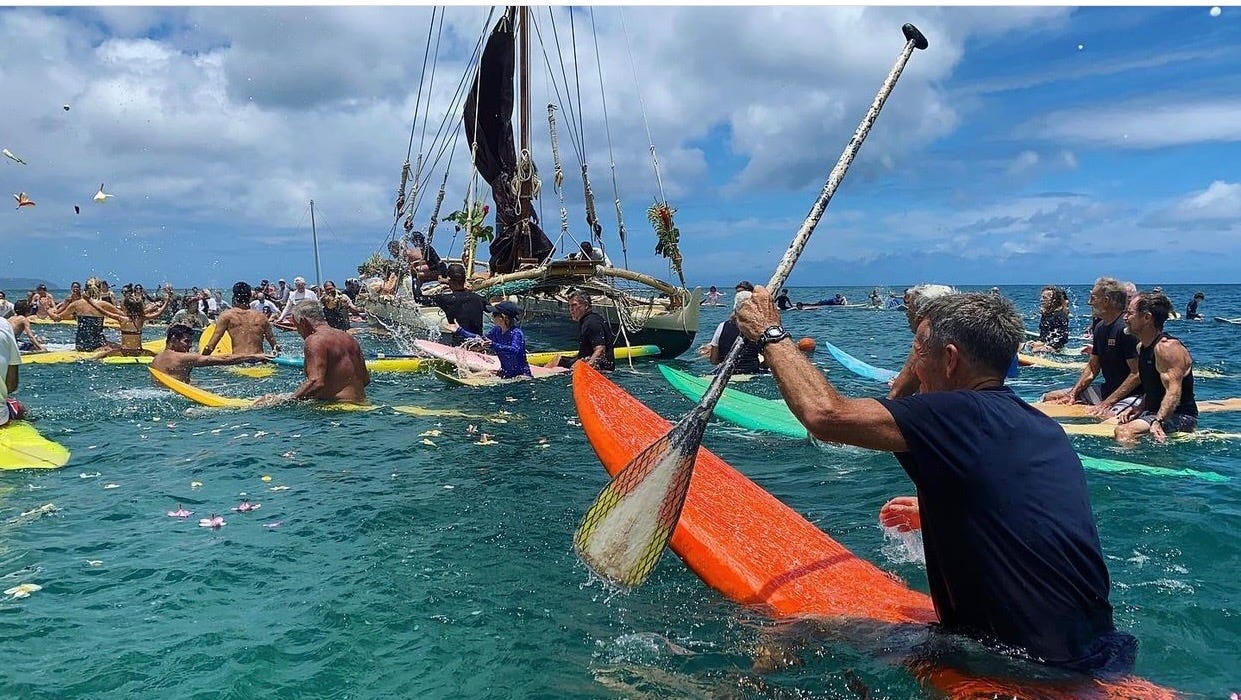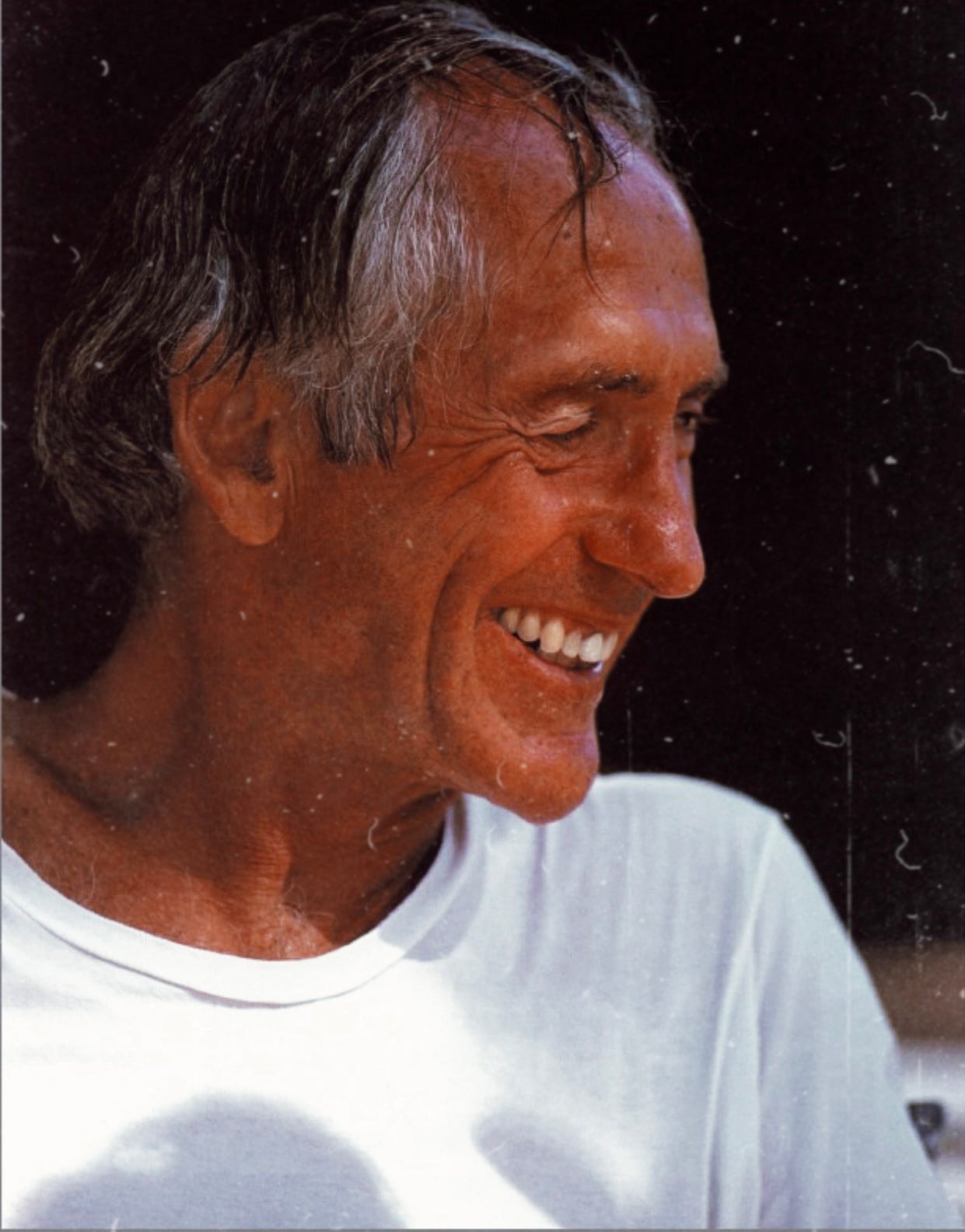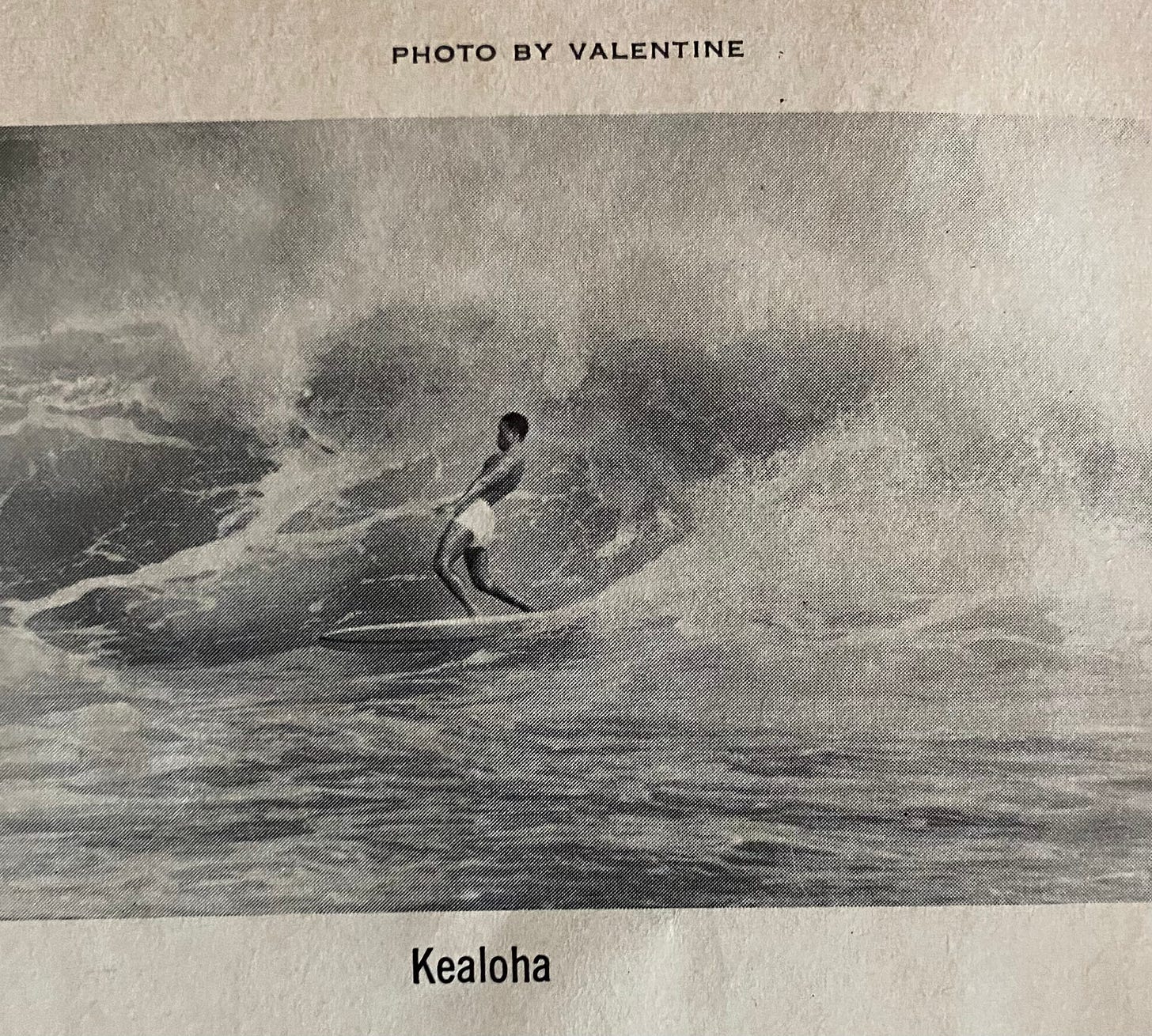
The Memorial for Peter Cole at Sunset Beach this past Saturday morning was halcyon and sublime. It all came together in a rather appropriate, organic way, Hawaiian style, with people, family, friends, surfing icons, and peers gradually showing up spontaneously from all over Oahu and elsewhere, far and wide. There was a Polynesian Outrigger Sailing Wa’a (canoe) moored in the channel, the same one at Derek Ho’s Memorial last summer down at Pipeline.1 Around 9:30 a.m., I paddled a white 11’ three stringer down the beach from where I live on Sunset Point, stashed my board on the beach in the naupaka, and crossed the Kam Highway to a large tent set up for the Memorial in the park.
People were gathering and talking story. Lots of familiar faces. Ken Bradshaw and Butch Perriera were discussing the “best day” ever at Sunset — October 4, 1976 — and agreed that they’d never seen or surfed anything quite like that outstanding 15’ North-Northwest before or since: confirmation of Peter’s judgment from two of the most seasoned, experienced surfers ever at Paumalu.2 Peter always loved that NNW direction, with the long wall stretching from Outside Boneyards off the Point (really Second/Third Reef Backyards) winding all the way through a myriad of sections — the North Point, Saddle, West Peak, & Inside Bowl — into the channel way outside the lifeguard tower. Anyone who’s seen or ridden one of these Leviathans won’t forget it. Pure stoke.
The Cole family (at least three generations) — Peter’s wife Sally, their sons Peter & Doug, and Peter’s eldest son, over from the Big Island, the renown waterman, Ka’aina, and the grandchildren — was assembled beneath the tent, welcoming and speaking graciously with guests, young and old, as they arrived and paid their respects, the keikis running circles amongst the seats and crowd. Peter’s stepdaughter Kaulana sat front and center in the grass. Looking around, I recognized many of those that compose and define the sociology and history of the North Shore, a rich, varied tapestry of characters from within and around the rural, residential community that revolves, in one way or another, around surfing. Paumalu is the epicenter. Everyone was smiling, happy, relaxed and convivial. No tears, at least not yet.
Douglass V.Z. Cole, Peter’s youngest, served as the informal MC. Reserved, dignified, eloquent, and in control, he reminded me of his father with a deep baritone and calm assurance that everything would proceed according to plan. Peter’s quiver of yellow guns was prominently and carefully strapped to the tent poles on each side, representing pillars, a distinguished tribute to decades of surfing history: Eaton, Brewer, Diffenderfer, Chapman, Andrus, Bradshaw, Walden, Bushman, Willis Bros., Y-Ban, and more stood proudly in Stoic, silent homage to a rich surfing life. I recognized many of the boards and recalled the hundreds — no thousands — of sessions I had the pleasure and privilege of sharing with Peter, a joy that many of those in attendance also shared.
The PA was whining with high-pitched feedback. No big deal. We could still hear what was said clear enough. Peter’s younger brother, Lucky, spoke at length. The Cole kindness, wit, and intelligence were on full display, as Lucky reflected on the dynamic between his older twin brothers, Corny and Peter, who were so small when born that they both “fit in a shoebox.”
He began with an analogy to ping-pong, telling us that Corny (a famous, award-winning artist) was a “sinker and slider”; whereas, on the other hand, Peter was the “slammer” (at least that’s what I think he said), in that Corny’s rather more nuanced approach to the game was contrasted by Peter’s raw powerful style (or lack thereof). This distinction apparently carried over into other activities, such as boxing. Corny was known for a method of combining a flurry of rapid jabs with inside cuts — he was a pressure fighter or “swarmer” — compared with Peter, who was a rather more aggressive brute, a “slugger” that threw wild haymakers and aimed for maximum impact. However, in Lucky’s considered estimation, Corny out-boxed his twin more often than not, to the everlasting frustration and chagrin of Peter.
Lucky declared that Peter was “more of a mentor” to him than Corny, for Peter inspired his youngest brother with a unique combination of courage, passion, humor, humility, and integrity, especially when it came to surfing, swimming, and competition. The deep love and admiration he had for Peter was palpable. Lucky observed that if the notorious Greg Noll (another fellow big-wave pioneer) was “The Bull,” then Peter was “The Lion” — the one who waited patiently, like a lone predator, for the best, biggest waves furthest outside at Paumalu and Waimea Bay. Lucky concluded with the insight that “Peter left a good wake behind him,” one that we all can draft and draw upon.
Peter’s tall, beautiful wife, Sally, draped in leis, spoke next. Not one to mince words or get too sentimental, she simply, succinctly stated that her husband “had a happy life” and “that he enjoyed all of your company . . . he really did.” Poignant, sweet, and true: a “happy life” — Eudaimonia — indeed.3 One can’t hope or ask for more.
Peter’s longtime surfing partner and neighbor, Jim Blattau — one of the truly great underground big-wave riders of all time in my book4 — reminisced on how he and Peter “slept in their cars on Ke Nui Road” back in the late 1950s (“when a beachfront lot sold for $2000, if you can believe that”); and how Peter and his friends (Fred Van Dyke and Ricky Grigg) essentially hanaied (adopted) Jim into a big-wave fraternity that he described as “family.” Jim’s gentle words touched me unexpectedly and a tear welled in my eye as he proclaimed a deep love and admiration for his “friend and mentor,” one he sorely missed.
Larry McElheny, another of Peter’s friends and a leading North Shore community activist, recalled his colleague’s strength, integrity, and civic virtue. Peter’s stepdaughter Kaulana, warmly related further how caring and protective her “father” was of her, teaching her to swim, read, and eat her vegetables (while arguing with the Hawaiian grandmother about something silly). Peter’s eldest son, Ka’aina — one of the most respected fishermen and divers in the Hawaiian Islands — shared fond memories of being “born and raised on the beach,” tumbling in the shore-break out front of the house before he could even walk. And Peter (the son, Sally’s eldest) spoke purely and profoundly of his father’s legacy in terms of the positive, edifying impact his father had on family and friends alike.
I scanned the crowd of faces and noticed Clyde Aikau sitting by himself, looking fit, proud, and healthy (he’s almost 72), listening intently. It was obvious to me that he was feeling the Mana (spiritual power) of the moment and that he was thinking hard. Clyde’s an intense person, another one of the true legends and greats of Hawaiian big-wave surfing history, along with his brother, of course: Eddie. Clyde is essentially the closest thing we have to living Ali’i Nui (great chief or noble leader), revered and respected by all.5 I could see that Clyde wanted to say or do something, so it seemed perfectly natural (to me) when he rose and approached the tent. My eyes followed him as he made his way toward the family and he said something to Doug, who immediately introduced Clyde.
This was the best, most moving part, in my opinion — a full-on chicken skin moment — as Clyde, speaking soulfully, began: “Two young Hawaiians, Eddie Aikau and myself, Clyde Aikau.” His was a heartfelt testimony to the “inspiration” Peter afforded two kids as they watched surf movies at the Waikiki Shell back in the mid 1960s (“66-67”). Just watch and listen to the video above . . . it will touch and teach you plenty, as Clyde recounts, with tears of gratitude and joy, how “the inspiration for Eddie and my myself came from Peter Cole and another Hawaiian surfer, Kealoha Kaio. These two guys inspired Eddie and myself to ride big waves.”6 That’s a huge declaration coming from a peerless authority. With genuine affection and admiration, Clyde reflected on his and Eddie’s experience surfing Sunset with Peter, waiting each day for Sally and Peter to come walking casually down the beach (Peter, said Clyde, was “a take your time guy” —no rush) before they all paddled out together “and surfed all day long.” Clyde went on:
Trying to be a part of the big-wave crew in the early days wasn’t the easiest thing . . . you was in or you was out. And Peter was instrumental in bringing Eddie and me into the realm of big-wave riding with everybody else. You know, in life, we’re all gonna reach that day when it’s time for us to leave. But what I think is really important is that you can leave something that can inspire people — you can inspire them to be a better person, a better athlete. I think that that is what really, really matters to Eddie and my family. We can leave when it’s time for us and to leave this world a little better place . . . Mahalo and Aloha Nō.
Sounded like something Peter might say himself . . . Authentic and true. I am quite certain that Clyde’s impromptu tribute to Peter Cole was the most important and beautiful testimony that I have ever witnessed in my surfing experience. His thoughtful reflections reminded and reinforced for me that we are all but links in a chain that extends for all eternity through time and space. Although here now but for a moment, the legacy of love, passion, and integrity from people like Peter (Clyde, Eddie . . . and on and on) transcends all limits or constraints of mortality or finitude in ways that can and will inspire generations to come. Mahalo and Aloha Nō.
With that said and done, we gathered our boards and paddled out to celebrate the life of a true legend as his ashes were scattered in the sacred waters — Mana Kai — of Paumalu.
Ho‘ohihi ko‘u mana‘o ‘eā
I ko leo ma ke kelepona
E haha‘i ana i kō moe ‘ole i ka pō
A ka hana nui a loko
E lauwiliwili nei
Aloha nō, aloha nō, aloha nō
‘O ‘oe ku‘u lei, ku‘u mili ē
He aloha nā maka i ka haka pono mai
Ua ‘ike au he ‘i‘ini kou na‘u
Ma ku‘u poli mai ‘oe
E nanea ai kāua
Aloha nō, aloha nō, aloha nō.
Aloha ‘Oe, Peter — Aloha Nō

Pau
Huelo Hale, Paumalu 2022
Once asked about “the best day ever” at Sunset Beach, Peter recalled a pristine fall day in October — “October 4 to be exact” — in 1976. Long before surf forecasts, Peter was the man when it came to predicting swells, for he had intimate knowledge of the science of meteorology and the source, such as the fabled “Kamchatka Low.” He recalled: “It was a freak swell from a storm way up there, almost into Russia, with very high winds. It had perfect direction, a North-Northwest, with long lines and solid 15’ waves. Kimo [Hollinger] was watching Outside Backyards and decided to paddle over there, so Eddie [Aikau] and I joined him. We were so far out, we could see Turtle Bay to the North. I got a wave from Backyards all the way through the channel. Never slowed down! You know, I’ve never had a wave even close to equaling that . . . I was high for two weeks! That’s the thing about Sunset. Just one good wave, and the drudgery of life doesn’t seem so bad.”
For Aristotle, eudaimonia — εὐδαιμονία —is the highest human good, the only human good that is desirable for its own sake (as an end in itself) rather than for the sake of something else (as a means toward some other end). Central to Hellenistic ethics, and otherwise often translated as “happiness,” “good spirit,” or “human flourishing,” Aristotle elucidated the philosophical meaning of eudaimonia in more precise terms of “an activity of the soul in accordance with virtue.”
I clearly remember the first time I saw Jim Blattau at Paumalu. He knee paddled a big gun (a three or five stringer 11’ plus single fin) from his beachfront home down at Rocky Point. As he approached the lineup, way outside on the Second Reef (The West Finger Reef as I was told by another legend: Steve Bigler), a set rose out of the deep and stood tall. Jim calmly stroked (still knee paddling) into this 12’+ West Peak, with the offshore Tradewinds sending the Ehukai (spray) high into the air, jumped to his feet, and effortlessly took the steep, nearly vertical drop. It was one of the most beautiful, graceful things I had ever seen. Owl Chapman, sitting on his board next to me, said: “That’s style.”
In ancient, traditional Hawaiian society, the Aliʻi were hereditary nobles (a social class or caste at the top of the cultural pyramid). The Aliʻi consisted of the higher and lesser chiefs of the various levels on the islands. The Noho Aliʻi Nui were the ruling chiefs. Aliʻi Nui were believed also to be descended from the Akua (Gods or deities).
Daniel Kealoha Kaio of Laie/Kahuku (Northeast Oahu) was born in 1935 and began surfing in 1958, the year Peter arrived on the North Shore. Kealoha soon became a regular out at Paumalu and by 1963 was one of the best, a strong, courageous, elegant surfer, who was admired by all for his control and style. Kealoha, a commercial fisherman by trade, was also an admired Hawaiian musician and singer, known for a beautiful falsetto voice. I have had the pleasure of having both Kealoha’s grandson (Kealoha III) and greatgrandson (Kealoha IV) as students at Kahuku High School — both of whom look just like Kealoha Senior and are outstanding football players. I surfed Sunset with Kealoha Senior a couple of times back in the 1990s, which was something I’ll never forget and always cherish.





